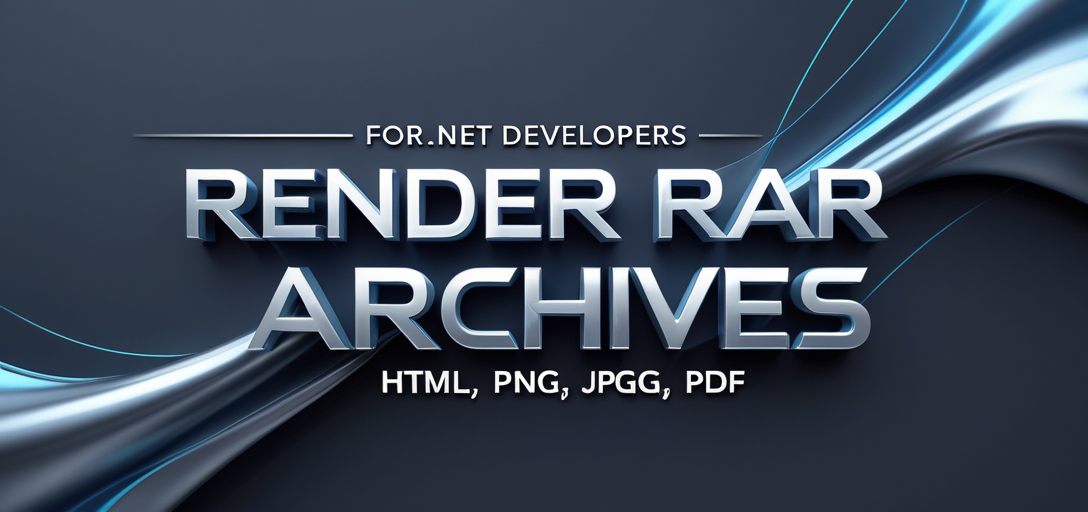How to Render RAR Archives to Various Formats Using GroupDocs.Viewer .NET
In today’s data-driven world, managing and sharing compressed files like RAR archives efficiently is crucial. Whether you’re a developer integrating file conversion capabilities into your application or someone needing to extract content from RAR files for various purposes, GroupDocs.Viewer for .NET offers robust solutions. In this tutorial, we’ll explore how to render RAR archives into HTML, JPG, PNG, and PDF formats using GroupDocs.Viewer for .NET.

What You’ll Learn:
- How to set up GroupDocs.Viewer for .NET.
- Techniques to render RAR files to different formats (HTML, JPG, PNG, PDF).
- Tips for retrieving view information from RAR documents.
- Methods to render specific folders within an archive.
Prerequisites
Before we begin, ensure you have the following:
- .NET Development Environment: Visual Studio or any compatible IDE that supports .NET development.
- GroupDocs.Viewer for .NET Library: You’ll need version 25.3.0 of this library to follow along with the code examples provided here.
Required Libraries and Dependencies
You can install GroupDocs.Viewer using either NuGet Package Manager Console or .NET CLI:
NuGet Package Manager Console
Install-Package GroupDocs.Viewer -Version 25.3.0
.NET CLI
dotnet add package GroupDocs.Viewer --version 25.3.0
License Acquisition
GroupDocs.Viewer offers a free trial, temporary licenses for evaluation purposes, and purchase options for full usage rights. You can download the library here or get a temporary license here.
Environment Setup
Ensure your development environment is set up with .NET Core or .NET Framework depending on your project requirements. Familiarity with C# programming and basic understanding of file I/O operations will be beneficial.
Setting Up GroupDocs.Viewer for .NET
Once you’ve installed the library, initialize it to start rendering files. Here’s a quick setup snippet:
using GroupDocs.Viewer;
// Initialize viewer object using a sample RAR file path.
using (Viewer viewer = new Viewer("YOUR_DOCUMENT_DIRECTORY/sample.rar"))
{
// Example view options for HTML rendering
HtmlViewOptions options = HtmlViewOptions.ForEmbeddedResources();
viewer.View(options);
}
This basic example demonstrates how to open a RAR file and prepare it for viewing or conversion.
Implementation Guide
We’ll now break down the tutorial into different sections, each focusing on rendering RAR archives to various formats using GroupDocs.Viewer.
Rendering RAR to HTML
Rendering RAR files to HTML can be useful for previewing content in web applications. Here’s how you do it:
Initialization and Setup
- Create Output Directory: Determine where the converted files will be saved.
- Set File Path Format: Specify a format string that includes placeholders for dynamic file naming.
string outputDirectory = Path.Combine("YOUR_DOCUMENT_DIRECTORY", "Output");
string pageFilePathFormat = Path.Combine(outputDirectory, "RAR_result_{0}.html");
using (Viewer viewer = new Viewer(Path.Combine("YOUR_DOCUMENT_DIRECTORY", "sample.rar")))
{
HtmlViewOptions options = HtmlViewOptions.ForEmbeddedResources(pageFilePathFormat);
viewer.View(options);
}
Explanation
- HtmlViewOptions: Configures rendering to HTML with embedded resources for better integration in web apps.
Rendering RAR to JPG
For cases where image previews are preferable, such as in document management systems:
string outputDirectory = Path.Combine("YOUR_DOCUMENT_DIRECTORY", "Output");
string pageFilePathFormat = Path.Combine(outputDirectory, "RAR_result_{0}.jpg");
using (Viewer viewer = new Viewer(Path.Combine("YOUR_DOCUMENT_DIRECTORY", "sample.rar")))
{
JpgViewOptions options = new JpgViewOptions(pageFilePathFormat);
viewer.View(options);
}
Rendering RAR to PNG
Similar to JPG, but with different use cases such as high-resolution displays:
string outputDirectory = Path.Combine("YOUR_DOCUMENT_DIRECTORY", "Output");
string pageFilePathFormat = Path.Combine(outputDirectory, "RAR_result_{0}.png");
using (Viewer viewer = new Viewer(Path.Combine("YOUR_DOCUMENT_DIRECTORY", "sample.rar")))
{
PngViewOptions options = new PngViewOptions(pageFilePathFormat);
viewer.View(options);
}
Rendering RAR to PDF
Converting RAR files to PDF is ideal for sharing documents in a widely accepted format:
string outputDirectory = Path.Combine("YOUR_DOCUMENT_DIRECTORY", "Output");
string pageFilePathFormat = Path.Combine(outputDirectory, "RAR_result.pdf");
using (Viewer viewer = new Viewer(Path.Combine("YOUR_DOCUMENT_DIRECTORY", "sample.rar")))
{
PdfViewOptions options = new PdfViewOptions(pageFilePathFormat);
viewer.View(options);
}
Getting View Info for RAR
To retrieve metadata such as page count:
string rarFilePath = Path.Combine("YOUR_DOCUMENT_DIRECTORY", "sample.rar");
using (Viewer viewer = new Viewer(rarFilePath))
{
ViewInfo info = viewer.GetViewInfo(ViewInfoOptions.ForHtmlView());
string fileType = info.FileType;
int pageCount = info.Pages.Count;
}
Rendering Specific Archive Folder
If you need to render only a specific folder within an archive:
string outputDirectory = Path.Combine("YOUR_DOCUMENT_DIRECTORY", "Output");
string pageFilePathFormat = Path.Combine(outputDirectory, "archive_folder_page_{0}.html");
using (Viewer viewer = new Viewer(Path.Combine("YOUR_DOCUMENT_DIRECTORY", "sample.rar")))
{
HtmlViewOptions options = HtmlViewOptions.ForEmbeddedResources(pageFilePathFormat);
options.ArchiveOptions.Folder = "/with_folders/ThirdFolderWithItems";
viewer.View(options);
}
Practical Applications
- Document Management Systems: Integrating file conversion to HTML, PDF, or images for easier viewing and sharing.
- Web Applications: Rendering RAR contents directly on a web page enhances user experience by avoiding download requirements.
- Archiving Solutions: Providing previews of archived files without extracting them fully.
Performance Considerations
To ensure optimal performance when using GroupDocs.Viewer:
- Manage memory efficiently, especially with large files, to prevent excessive resource usage.
- Use asynchronous methods where possible to avoid blocking operations in your application.
- Fine-tune the rendering options based on output quality and processing speed requirements.
Conclusion
In this tutorial, you’ve learned how to use GroupDocs.Viewer for .NET to render RAR archives into various formats. This capability can significantly enhance document management and sharing features within applications. For further exploration, consider integrating these functionalities with other .NET frameworks or systems to broaden your application’s capabilities.
Next Steps:
- Experiment with different rendering options.
- Explore GroupDocs.Viewer documentation for advanced features.
FAQ Section
- Can I render encrypted RAR files?
- Yes, GroupDocs.Viewer supports password-protected archives, but you’ll need to provide the correct decryption key.
- How do I handle large RAR files efficiently?
- Use streaming and asynchronous methods to manage memory usage effectively.
- Is it possible to customize HTML rendering output?
- Absolutely! GroupDocs.Viewer offers customization options for CSS and embedded resources.
- What are the system requirements for running GroupDocs.Viewer on a server?
- Ensure your environment meets .NET Framework/.NET Core compatibility and has sufficient memory for processing files.
- How can I get support if I encounter issues with GroupDocs.Viewer?
- Visit the GroupDocs Support Forum.